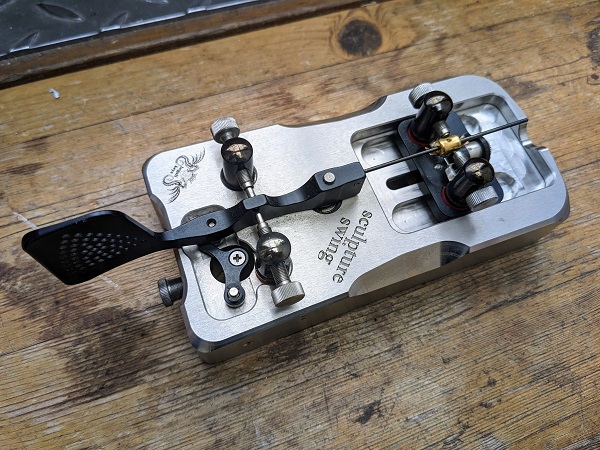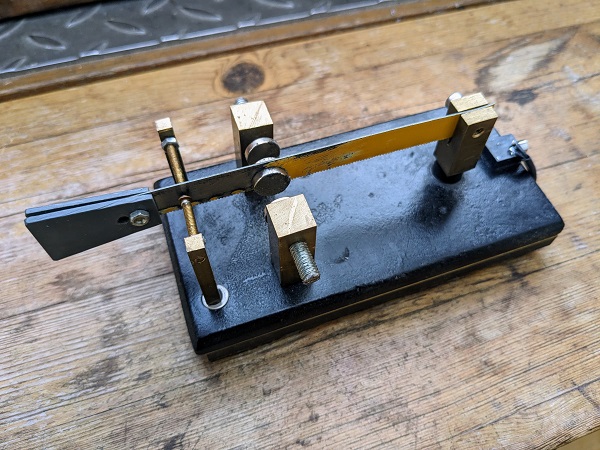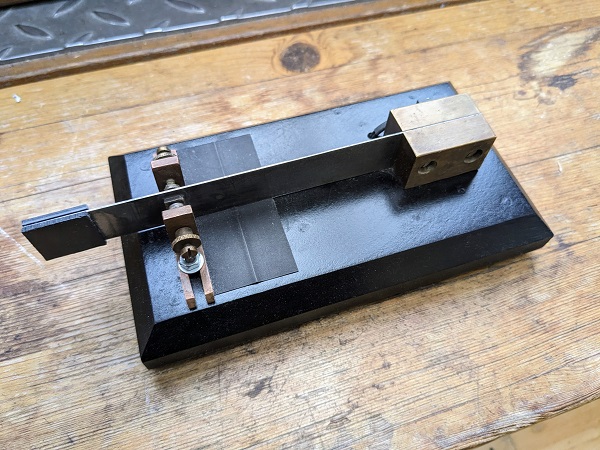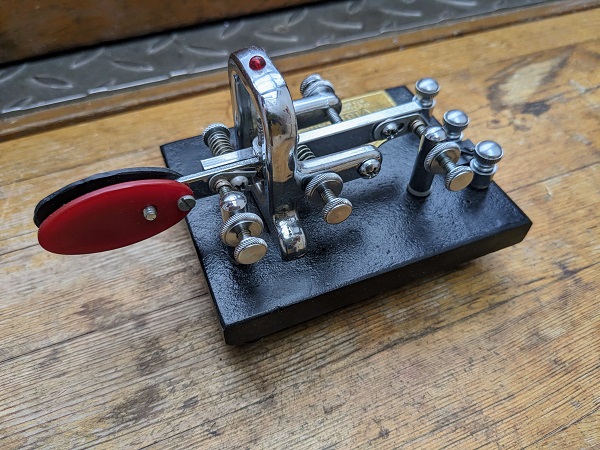PG4I's keys.
Introduction.
After having acquired my license in 1977 and making a couple of QSO's with a straight key, I switched to a Bencher paddle which served me for several years. I was a very active contester using the callsign PA3ABA and also was participating in several multi-multi stations. At some point I became more interested in the technical aspects of Amateur Radio and until 2018 I hardly made any QSO's but spent most of the time homebrewing equipment. Then a friend (now YL3JD) told me he was interested in learning CW which somehow motivated me to get back on the air. Being a member of the SKCC (Straight Key Century Club) I began participating in their activities and discovered the joy of operating mechanical keys: straight keys, bugs and sideswipers. 50 percent of my QSO's now are done with a bug or sideswiper with the occasional QRS QSO using a straight key. My first sideswiper was a metal ruler screwed onto a piece of wood and attached to a table with a clamp screw! [PG4I].
The Begali Sculpture Swing.
 My daily key is the Begali Sculpture Swing. Although my only experience with a commercial sideswiper I would call it the ultimate key! Just about everything on this key is adjustable. Contact tension, contact distance, lever tension/damping, return force and arm length. All very easy to control. I like using this key with a light touch and a relatively short arm for the higher speeds up to 25 wpm. But at the same time, using the key at around 12 wpm with the same configuration is no problem.
[PG4I].
My daily key is the Begali Sculpture Swing. Although my only experience with a commercial sideswiper I would call it the ultimate key! Just about everything on this key is adjustable. Contact tension, contact distance, lever tension/damping, return force and arm length. All very easy to control. I like using this key with a light touch and a relatively short arm for the higher speeds up to 25 wpm. But at the same time, using the key at around 12 wpm with the same configuration is no problem.
[PG4I].
Homebrew Hacksaw Blade SideSwiper.
 I made several attempts trying to create a sideswiper with a hacksaw blade. The metal base was taken from an old bug which needed a much heavier base anyway. The first versions would still move around the table and vibrate uncontrollably. The base was made heavier by adding a thick piece of brass. A couple of small magnets were used to provide some damping. Contacts were made from an old relay. Overall, this key was cheap to make and operation is easy. I tend to take this key with me on holidays because of it's robustness.
[PG4I].
I made several attempts trying to create a sideswiper with a hacksaw blade. The metal base was taken from an old bug which needed a much heavier base anyway. The first versions would still move around the table and vibrate uncontrollably. The base was made heavier by adding a thick piece of brass. A couple of small magnets were used to provide some damping. Contacts were made from an old relay. Overall, this key was cheap to make and operation is easy. I tend to take this key with me on holidays because of it's robustness.
[PG4I].
Long Arm QRS Sideswiper.
 This key came with an internet sale and was included with homebrew transceiver. The flexible arm is mounted onto a heavy piece of wood as a base. When I got this key it was in a very bad state, so I filled up all the holes in the wooden base with some filler, sanded it and painted it black to cover up all the scars. A piece of shrink tube was glued to the base to provide some damping. Because of the long arm this key is suitable for lower speeds. It has a very distinct sound.
[PG4I].
This key came with an internet sale and was included with homebrew transceiver. The flexible arm is mounted onto a heavy piece of wood as a base. When I got this key it was in a very bad state, so I filled up all the holes in the wooden base with some filler, sanded it and painted it black to cover up all the scars. A piece of shrink tube was glued to the base to provide some damping. Because of the long arm this key is suitable for lower speeds. It has a very distinct sound.
[PG4I].
Vibrokeyer Sideswiper.
 This key was given to me by PA0DIN (SK). He told me it used to belong to a blind hamradio operator. The base of this key was full of holes and had a dull beige color. The holes were used to attach the key to a table when operating. After sanding and filling up the holes I painted the base black and it looked much nicer. Because dots and dashed are swapped on my paddles, I converted the key from right-handed to left-handed by turning the lever upside down and moving all of the contacts to the other side. But I never liked the feel of this key as a paddle. So I converted the key to a sideswiper by removing the big knob and copying the thumb piece to the other side. Sending with this key as a sideswiper is a bit odd because of the rigidness of the lever, there is no flex. But if you increase the contact spacing, it can produce reasonable code.
[PG4I].
This key was given to me by PA0DIN (SK). He told me it used to belong to a blind hamradio operator. The base of this key was full of holes and had a dull beige color. The holes were used to attach the key to a table when operating. After sanding and filling up the holes I painted the base black and it looked much nicer. Because dots and dashed are swapped on my paddles, I converted the key from right-handed to left-handed by turning the lever upside down and moving all of the contacts to the other side. But I never liked the feel of this key as a paddle. So I converted the key to a sideswiper by removing the big knob and copying the thumb piece to the other side. Sending with this key as a sideswiper is a bit odd because of the rigidness of the lever, there is no flex. But if you increase the contact spacing, it can produce reasonable code.
[PG4I].

